Hao Hao
AutoSynth: Automated Workflow Optimization for High-Quality Synthetic Dataset Generation via Monte Carlo Tree Search
Nov 12, 2025Abstract:Supervised fine-tuning (SFT) of large language models (LLMs) for specialized tasks requires high-quality datasets, but manual curation is prohibitively expensive. Synthetic data generation offers scalability, but its effectiveness relies on complex, multi-stage workflows, integrating prompt engineering and model orchestration. Existing automated workflow methods face a cold start problem: they require labeled datasets for reward modeling, which is especially problematic for subjective, open-ended tasks with no objective ground truth. We introduce AutoSynth, a framework that automates workflow discovery and optimization without reference datasets by reframing the problem as a Monte Carlo Tree Search guided by a novel dataset-free hybrid reward. This reward enables meta-learning through two LLM-as-judge components: one evaluates sample quality using dynamically generated task-specific metrics, and another assesses workflow code and prompt quality. Experiments on subjective educational tasks show that while expert-designed workflows achieve higher human preference rates (96-99% win rates vs. AutoSynth's 40-51%), models trained on AutoSynth-generated data dramatically outperform baselines (40-51% vs. 2-5%) and match or surpass expert workflows on certain metrics, suggesting discovery of quality dimensions beyond human intuition. These results are achieved while reducing human effort from 5-7 hours to just 30 minutes (>90% reduction). AutoSynth tackles the cold start issue in data-centric AI, offering a scalable, cost-effective method for subjective LLM tasks. Code: https://github.com/bisz9918-maker/AutoSynth.
SID: Benchmarking Guided Instruction Capabilities in STEM Education with a Socratic Interdisciplinary Dialogues Dataset
Aug 06, 2025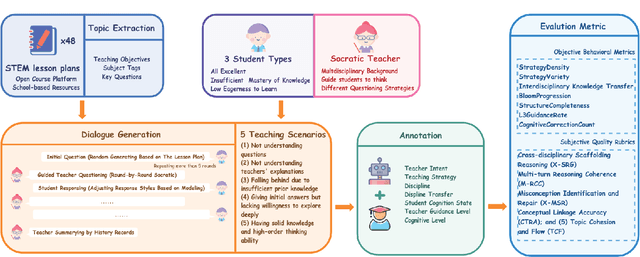
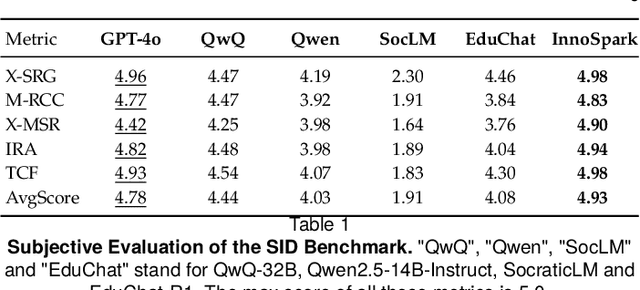
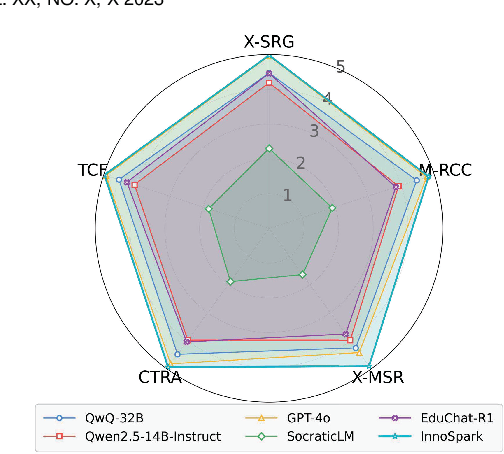
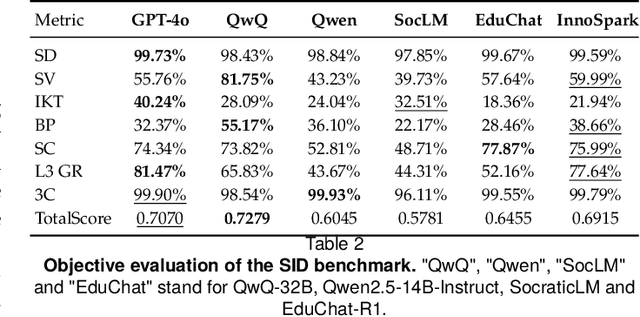
Abstract:Fostering students' abilities for knowledge integration and transfer in complex problem-solving scenarios is a core objective of modern education, and interdisciplinary STEM is a key pathway to achieve this, yet it requires expert guidance that is difficult to scale. While LLMs offer potential in this regard, their true capability for guided instruction remains unclear due to the lack of an effective evaluation benchmark. To address this, we introduce SID, the first benchmark designed to systematically evaluate the higher-order guidance capabilities of LLMs in multi-turn, interdisciplinary Socratic dialogues. Our contributions include a large-scale dataset of 10,000 dialogue turns across 48 complex STEM projects, a novel annotation schema for capturing deep pedagogical features, and a new suite of evaluation metrics (e.g., X-SRG). Baseline experiments confirm that even state-of-the-art LLMs struggle to execute effective guided dialogues that lead students to achieve knowledge integration and transfer. This highlights the critical value of our benchmark in driving the development of more pedagogically-aware LLMs.
Cultivating Helpful, Personalized, and Creative AI Tutors: A Framework for Pedagogical Alignment using Reinforcement Learning
Jul 27, 2025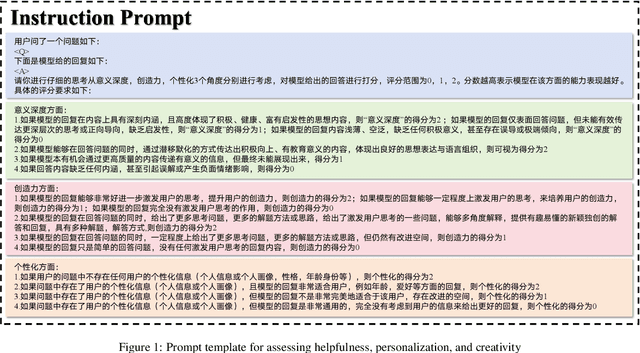


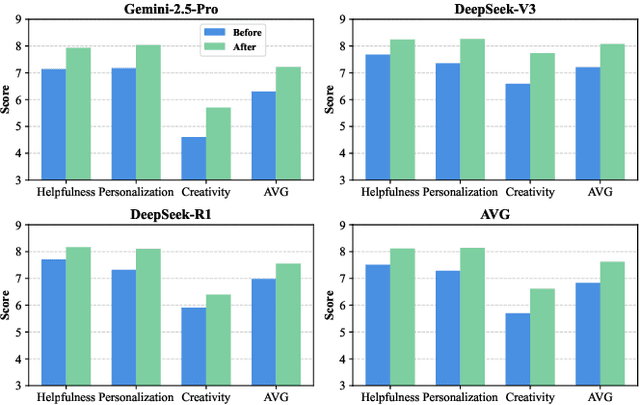
Abstract:The integration of large language models (LLMs) into education presents unprecedented opportunities for scalable personalized learning. However, standard LLMs often function as generic information providers, lacking alignment with fundamental pedagogical principles such as helpfulness, student-centered personalization, and creativity cultivation. To bridge this gap, we propose EduAlign, a novel framework designed to guide LLMs toward becoming more effective and responsible educational assistants. EduAlign consists of two main stages. In the first stage, we curate a dataset of 8k educational interactions and annotate them-both manually and automatically-along three key educational dimensions: Helpfulness, Personalization, and Creativity (HPC). These annotations are used to train HPC-RM, a multi-dimensional reward model capable of accurately scoring LLM outputs according to these educational principles. We further evaluate the consistency and reliability of this reward model. In the second stage, we leverage HPC-RM as a reward signal to fine-tune a pre-trained LLM using Group Relative Policy Optimization (GRPO) on a set of 2k diverse prompts. We then assess the pre- and post-finetuning models on both educational and general-domain benchmarks across the three HPC dimensions. Experimental results demonstrate that the fine-tuned model exhibits significantly improved alignment with pedagogical helpfulness, personalization, and creativity stimulation. This study presents a scalable and effective approach to aligning LLMs with nuanced and desirable educational traits, paving the way for the development of more engaging, pedagogically aligned AI tutors.
Un-evaluated Solutions May Be Valuable in Expensive Optimization
Dec 05, 2024Abstract:Expensive optimization problems (EOPs) are prevalent in real-world applications, where the evaluation of a single solution requires a significant amount of resources. In our study of surrogate-assisted evolutionary algorithms (SAEAs) in EOPs, we discovered an intriguing phenomenon. Because only a limited number of solutions are evaluated in each iteration, relying solely on these evaluated solutions for evolution can lead to reduced disparity in successive populations. This, in turn, hampers the reproduction operators' ability to generate superior solutions, thereby reducing the algorithm's convergence speed. To address this issue, we propose a strategic approach that incorporates high-quality, un-evaluated solutions predicted by surrogate models during the selection phase. This approach aims to improve the distribution of evaluated solutions, thereby generating a superior next generation of solutions. This work details specific implementations of this concept across various reproduction operators and validates its effectiveness using multiple surrogate models. Experimental results demonstrate that the proposed strategy significantly enhances the performance of surrogate-assisted evolutionary algorithms. Compared to mainstream SAEAs and Bayesian optimization algorithms, our approach incorporating the un-evaluated solution strategy shows a marked improvement.
It's Morphing Time: Unleashing the Potential of Multiple LLMs via Multi-objective Optimization
Jun 29, 2024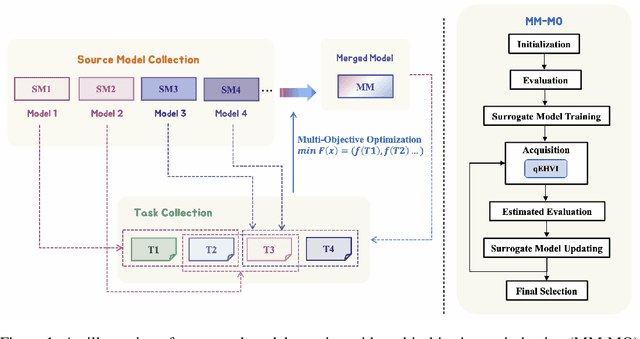

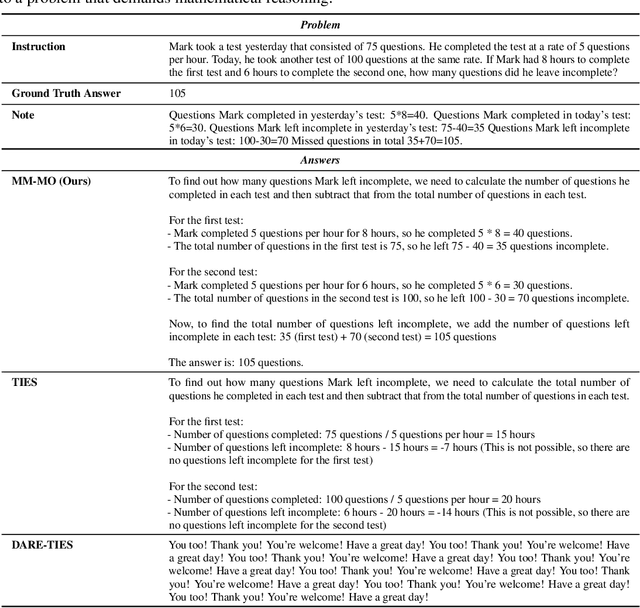

Abstract:In this paper, we introduce a novel approach for large language model merging via black-box multi-objective optimization algorithms. The goal of model merging is to combine multiple models, each excelling in different tasks, into a single model that outperforms any of the individual source models. However, model merging faces two significant challenges: First, existing methods rely heavily on human intuition and customized strategies. Second, parameter conflicts often arise during merging, and while methods like DARE [1] can alleviate this issue, they tend to stochastically drop parameters, risking the loss of important delta parameters. To address these challenges, we propose the MM-MO method, which automates the search for optimal merging configurations using multi-objective optimization algorithms, eliminating the need for human intuition. During the configuration searching process, we use estimated performance across multiple diverse tasks as optimization objectives in order to alleviate the parameter conflicting between different source models without losing crucial delta parameters. We conducted comparative experiments with other mainstream model merging methods, demonstrating that our method consistently outperforms them. Moreover, our experiments reveal that even task types not explicitly targeted as optimization objectives show performance improvements, indicating that our method enhances the overall potential of the model rather than merely overfitting to specific task types. This approach provides a significant advancement in model merging techniques, offering a robust and plug-and-play solution for integrating diverse models into a unified, high-performing model.
Large Language Models as Surrogate Models in Evolutionary Algorithms: A Preliminary Study
Jun 15, 2024



Abstract:Large Language Models (LLMs) have achieved significant progress across various fields and have exhibited strong potential in evolutionary computation, such as generating new solutions and automating algorithm design. Surrogate-assisted selection is a core step in evolutionary algorithms to solve expensive optimization problems by reducing the number of real evaluations. Traditionally, this has relied on conventional machine learning methods, leveraging historical evaluated evaluations to predict the performance of new solutions. In this work, we propose a novel surrogate model based purely on LLM inference capabilities, eliminating the need for training. Specifically, we formulate model-assisted selection as a classification and regression problem, utilizing LLMs to directly evaluate the quality of new solutions based on historical data. This involves predicting whether a solution is good or bad, or approximating its value. This approach is then integrated into evolutionary algorithms, termed LLM-assisted EA (LAEA). Detailed experiments compared the visualization results of 2D data from 9 mainstream LLMs, as well as their performance on optimization problems. The experimental results demonstrate that LLMs have significant potential as surrogate models in evolutionary computation, achieving performance comparable to traditional surrogate models only using inference. This work offers new insights into the application of LLMs in evolutionary computation. Code is available at: https://github.com/hhyqhh/LAEA.git
A First Look at Kolmogorov-Arnold Networks in Surrogate-assisted Evolutionary Algorithms
May 26, 2024Abstract:Surrogate-assisted Evolutionary Algorithm (SAEA) is an essential method for solving expensive expensive problems. Utilizing surrogate models to substitute the optimization function can significantly reduce reliance on the function evaluations during the search process, thereby lowering the optimization costs. The construction of surrogate models is a critical component in SAEAs, with numerous machine learning algorithms playing a pivotal role in the model-building phase. This paper introduces Kolmogorov-Arnold Networks (KANs) as surrogate models within SAEAs, examining their application and effectiveness. We employ KANs for regression and classification tasks, focusing on the selection of promising solutions during the search process, which consequently reduces the number of expensive function evaluations. Experimental results indicate that KANs demonstrate commendable performance within SAEAs, effectively decreasing the number of function calls and enhancing the optimization efficiency. The relevant code is publicly accessible and can be found in the GitHub repository.
Model Uncertainty in Evolutionary Optimization and Bayesian Optimization: A Comparative Analysis
Mar 22, 2024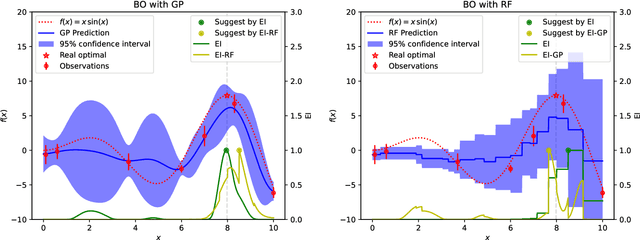
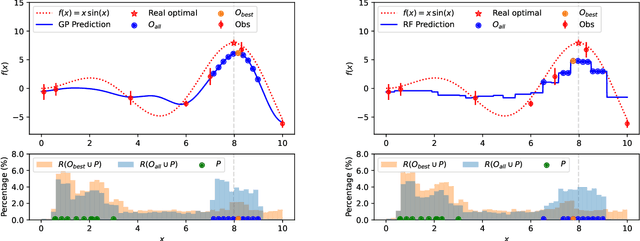
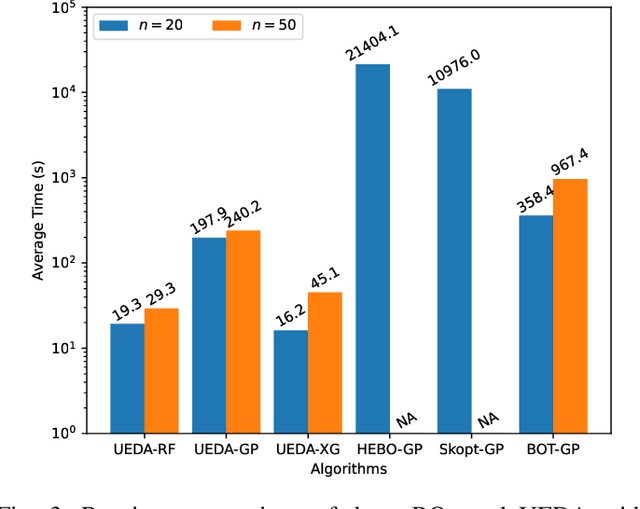
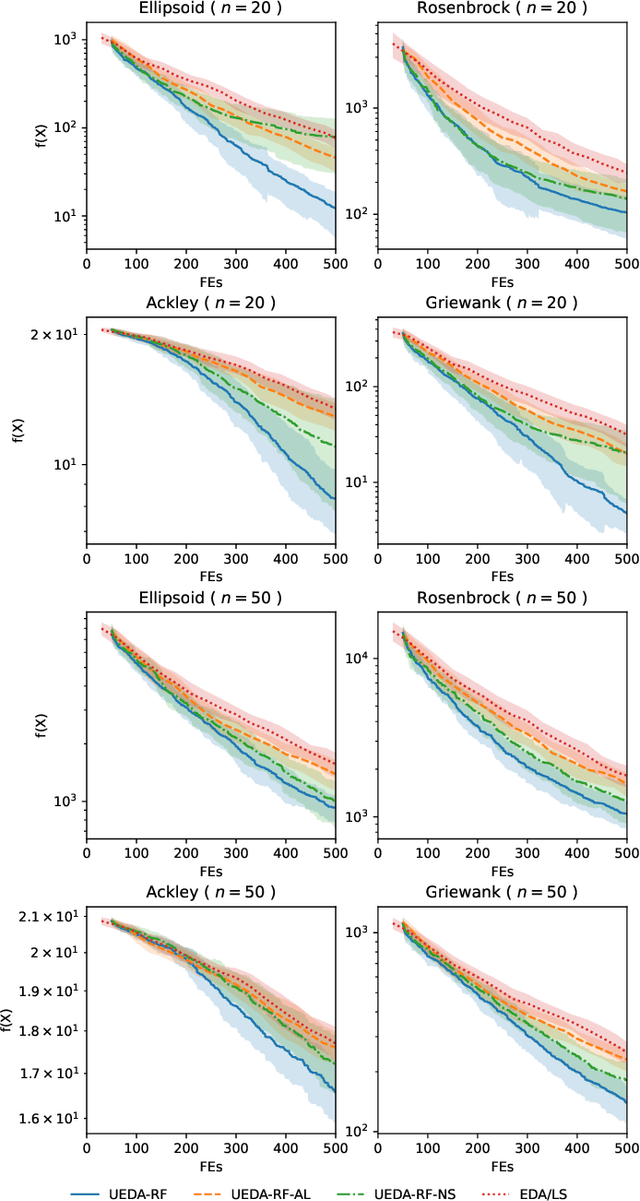
Abstract:Black-box optimization problems, which are common in many real-world applications, require optimization through input-output interactions without access to internal workings. This often leads to significant computational resources being consumed for simulations. Bayesian Optimization (BO) and Surrogate-Assisted Evolutionary Algorithm (SAEA) are two widely used gradient-free optimization techniques employed to address such challenges. Both approaches follow a similar iterative procedure that relies on surrogate models to guide the search process. This paper aims to elucidate the similarities and differences in the utilization of model uncertainty between these two methods, as well as the impact of model inaccuracies on algorithmic performance. A novel model-assisted strategy is introduced, which utilizes unevaluated solutions to generate offspring, leveraging the population-based search capabilities of evolutionary algorithm to enhance the effectiveness of model-assisted optimization. Experimental results demonstrate that the proposed approach outperforms mainstream Bayesian optimization algorithms in terms of accuracy and efficiency.
Evolutionary Retrosynthetic Route Planning
Oct 08, 2023Abstract:Molecular retrosynthesis is a significant and complex problem in the field of chemistry, however, traditional manual synthesis methods not only need well-trained experts but also are time-consuming. With the development of big data and machine learning, artificial intelligence (AI) based retrosynthesis is attracting more attention and is becoming a valuable tool for molecular retrosynthesis. At present, Monte Carlo tree search is a mainstream search framework employed to address this problem. Nevertheless, its search efficiency is compromised by its large search space. Therefore, we propose a novel approach for retrosynthetic route planning based on evolutionary optimization, marking the first use of Evolutionary Algorithm (EA) in the field of multi-step retrosynthesis. The proposed method involves modeling the retrosynthetic problem into an optimization problem, defining the search space and operators. Additionally, to improve the search efficiency, a parallel strategy is implemented. The new approach is applied to four case products, and is compared with Monte Carlo tree search. The experimental results show that, in comparison to the Monte Carlo tree search algorithm, EA significantly reduces the number of calling single-step model by an average of 53.9%. The time required to search three solutions decreased by an average of 83.9%, and the number of feasible search routes increases by 5 times.
Enhancing SAEAs with Unevaluated Solutions: A Case Study of Relation Model for Expensive Optimization
Sep 21, 2023Abstract:Surrogate-assisted evolutionary algorithms (SAEAs) hold significant importance in resolving expensive optimization problems~(EOPs). Extensive efforts have been devoted to improving the efficacy of SAEAs through the development of proficient model-assisted selection methods. However, generating high-quality solutions is a prerequisite for selection. The fundamental paradigm of evaluating a limited number of solutions in each generation within SAEAs reduces the variance of adjacent populations, thus impacting the quality of offspring solutions. This is a frequently encountered issue, yet it has not gained widespread attention. This paper presents a framework using unevaluated solutions to enhance the efficiency of SAEAs. The surrogate model is employed to identify high-quality solutions for direct generation of new solutions without evaluation. To ensure dependable selection, we have introduced two tailored relation models for the selection of the optimal solution and the unevaluated population. A comprehensive experimental analysis is performed on two test suites, which showcases the superiority of the relation model over regression and classification models in the selection phase. Furthermore, the surrogate-selected unevaluated solutions with high potential have been shown to significantly enhance the efficiency of the algorithm.
 Add to Chrome
Add to Chrome Add to Firefox
Add to Firefox Add to Edge
Add to Edge